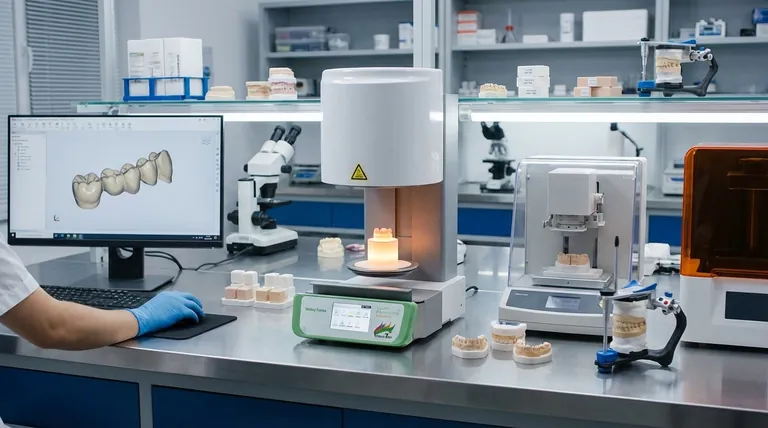A dental laboratory is a specialized manufacturing facility equipped with a range of advanced tools and materials used to create custom-made dental prosthetics and appliances. These labs function as the technical backend for dentists, fabricating everything from crowns and bridges to dentures and orthodontic devices based on a patient's specific impressions.
The core function of a dental laboratory is to translate a dentist's prescription into a precise, functional, and aesthetically pleasing dental restoration. It's a blend of artistry, science, and high-tech manufacturing.

The Core Functions of a Dental Laboratory
A dental lab isn't just a single room; it's often a series of specialized stations or departments, each dedicated to a particular stage of the fabrication process.
From Impression to Model
The process begins with the patient's impression, which serves as the blueprint. The lab's first job is to create a precise physical replica of the patient's mouth. This is the foundation upon which all other work is built.
The Role of Heating and Casting
Many dental restorations, particularly those made from metal alloys or specific ceramics, require casting. This involves creating a wax model of the final prosthetic and then using heat to replace that wax with the permanent material.
This is where specialized heating equipment becomes critical.
The Equipment for High-Heat Fabrication
Dental furnaces are central to the lab's operations. These high-temperature ovens are used for a variety of tasks, including sintering zirconia, firing ceramics onto metal frameworks, and heat-treating alloys to achieve the desired strength and durability.
The performance of these furnaces depends on their core components. Heating elements are the parts within the furnace that generate the extreme temperatures required for these processes.
To hold the materials during heating, technicians use crucibles. These are durable, heat-resistant containers designed to withstand the intense environment inside a furnace without contaminating the dental materials.
The Modern Shift: Digital Dentistry
While traditional casting and firing methods remain essential, modern labs are increasingly incorporating digital workflows.
CAD/CAM Technology
Computer-Aided Design (CAD) and Computer-Aided Manufacturing (CAM) have revolutionized the industry. Technicians now often work with digital scans of a patient's mouth to design restorations on a computer.
Milling and 3D Printing
Once the design is finalized, it's sent to a CAM unit, which could be a milling machine that carves the restoration from a solid block of ceramic or a 3D printer that builds it layer by layer from resin or other materials.
Understanding the Trade-offs
Traditional vs. Digital Workflows
The choice between traditional and digital methods involves a significant trade-off. Traditional, hands-on techniques allow for a high degree of artistry and customization but can be labor-intensive and subject to human error.
Digital workflows offer exceptional precision, speed, and repeatability. However, they require a substantial initial investment in equipment and training, and not all materials are suitable for milling or printing. Most modern labs use a hybrid approach to leverage the benefits of both.
Material Selection
The materials used, from porcelain and zirconia to metal alloys and acrylics, each have different properties. The lab must work closely with the dentist to select the best material based on the restoration's location, the patient's bite force, and aesthetic requirements.
How This Impacts Patient Outcomes
The quality of a dental laboratory's work directly affects the final result a patient receives.
- For a durable and long-lasting crown: The lab must use high-quality furnaces and crucibles to ensure the ceramic is fired at the correct temperature for maximum strength.
- For a precise and comfortable fit: The lab's ability to accurately translate a digital scan or physical impression into a final product is paramount, whether using traditional or digital methods.
- For a natural appearance: The skill of the technician in layering ceramics or selecting the right shade of material is what makes a restoration blend in seamlessly.
Ultimately, a dental laboratory serves as the critical link between the dentist's diagnosis and the patient's restored smile.
Summary Table:
| Key Component | Primary Function |
|---|---|
| Dental Furnaces | Sintering zirconia, firing ceramics, heat-treating alloys. |
| CAD/CAM Systems | Designing and manufacturing restorations digitally. |
| Crucibles | Holding materials during high-temperature processes. |
| Milling Machines / 3D Printers | Carving or building prosthetics from digital designs. |
Equip your dental laboratory for precision and efficiency.
KINTEK specializes in the advanced lab equipment that powers modern dentistry. From reliable dental furnaces and crucibles for perfect sintering and casting to supporting your transition into CAD/CAM workflows, we provide the tools for durable, aesthetically perfect patient outcomes.
Partner with KINTEK to enhance your lab's capabilities. Contact our experts today to discuss your specific equipment needs and ensure you have the right technology for superior restorations.
Visual Guide

Related Products
- Dental Porcelain Zirconia Sintering Ceramic Furnace Chairside with Transformer
- Vacuum Dental Porcelain Sintering Furnace
- 1800℃ Muffle Oven Furnace for Laboratory
- 1700℃ Laboratory Quartz Tube Furnace with Alumina Tube Tubular Furnace
- Laboratory Muffle Oven Furnace Bottom Lifting Muffle Furnace
People Also Ask
- What is the price of zirconia sintering furnace? Invest in Precision, Not Just a Price Tag
- What is one of the newest applications for dental ceramics? Monolithic Zirconia for Full-Arch Bridges
- What is the effect of zirconia sintering temperature? Master the Key to Strength and Stability
- Can you change the color of zirconia crowns? Understanding the Permanent Nature of Zirconia
- What is the sintering time for zirconia? A Guide to Precise Firing for Optimal Results



















